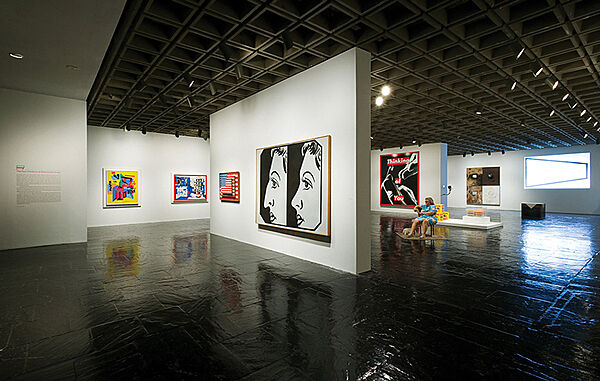Not on view
Date
1960–1966
Classification
Paintings
Medium
Oil on linen
Dimensions
Overall: 60 1/8 × 60 3/16in. (152.7 × 152.9 cm)
Accession number
98.16.5
Credit line
Whitney Museum of American Art, New York; purchase, with funds from The Lauder Foundation, Leonard and Evelyn Lauder Fund
Rights and reproductions
©Estate of Ad Reinhardt/Artists Rights Society (ARS)
Audio
-
0:00
Ad Reinhardt, Abstract Painting, 1960-1966
0:00
David Breslin: Me llamo David Breslin. Soy el Curador Familia DeMartini y Director de la Colección aquí en el Whitney.
Ad Reinhardt es un artista conocido principalmente por sus pinturas abstractas. Desde principios de los años cincuenta, comenzó a crear obras de arte que, a primera vista, solo parecen un campo de color negro; sin embargo, Ad Reinhardt era un artista profundamente comprometido con cuestiones políticas. En las décadas de 1930 y 1940, dibujó caricaturas satíricas para periódicos y revistas de izquierda. Parte de la idea de incluir una de las pinturas negras de Reinhardt fue pensar en artistas conocidos por sus obras de estudio, o sus pinturas, que, en apariencia, no son políticas. ¿Cómo podríamos considerar que esas obras han tenido mensajes políticos, en distintos momentos?
Así pues, para estas pinturas que comenzó en 1953 y en las que trabajó hasta su muerte en 1967, Reinhardt intentó eliminar casi todo aquello que fuera superfluo. Y tiene esta grandiosa serie de declaraciones en las que habla de las obras por lo que no son o lo que no tienen. Las llamó neutrales y sin forma, no grandes. Y cuando uno lee esta serie de “noes”, de “sines” o de “ausencias”, también lo ve al artista ensayando la idea de la negación o la resistencia. Resistencia al estatus quo. Resistencia a la historia de la pintura. Resistencia a los estándares de la época. En una sala en la que pensamos de qué manera veían la resistencia los distintos artistas del momento, nos pareció interesante, si no crucial, incluir la abstracción en ese argumento y pensar en Reinhardt en ese contexto.
-
0:00
Ad Reinhardt, Abstract Painting, 1960-1966
0:00
David Breslin: My name is David Breslin. I'm the DeMartini Family Curator and Director of the Collection here at the Whitney.
Ad Reinhardt is an artist known mostly for doing abstract paintings. Beginning in the early 1950s he began to make works that, upon first impression, only look like a field of black, but Ad Reinhardt was an artist who was deeply engaged in political issues. In the thirties and forties, he did the satirical cartoons for leftist newspapers and journals. Part of the thinking of including one of Reinhardt's black paintings was to think about artists who are known for making studio-based works, or a painting, that doesn't look political. How might we think of those having some political undertones, at different moments?
So for these paintings that he began in 1953 and worked on until his death in 1967, Reinhardt tried to strip away almost everything extraneous from them. And he has this great series of statements where he discusses them by what they aren't, or what they don't have. He called them neutral and shapeless, not large, formless. And when you read these series of “nos” or “withouts” or “absences” you also see him rehearsing a whole idea of negation or resistance. Resistance to the status quo. Resistance to the history of painting. Resistance to the standards of the day. In a gallery where we are thinking about what resistance looked like to different artist of that moment it seemed interesting, if not crucial, to include abstraction in that argument and to think about Reinhardt in that context.
-
0:00
May 22, 2015
Byron Kim on Abstract Painting by Ad Reinhardt0:00
-
0:00
Ad Reinhardt, Abstract Painting, 1960–66
0:00
Narrator: At first glance, this painting by Ad Reinhardt looks like a field of solid black. On closer inspection, you can see that there are subtle variations of tone. After 1953, Reinhardt made only black canvases. His simple, meditative works are the antithesis of the action paintings of the Abstract Expressionists like Jackson Pollock.
Contemporary artist Byron Kim talks about Reinhardt’s work:
Byron Kim: Often I’m surprised and overwhelmed by how beautiful they are. . . And I love Reinhardt’s black paintings more probably than any other artwork that I’ve come across. I think he meant them to be contentless. So he really wanted them to be nothing. So what happens when, you know, nobody wants to accept that something is about nothing, or that art is only about art. So once you say that, then people inevitably start to relate these paintings to something, or try to make them metaphysical, try to relate them to something outside of the painting somehow. You don’t know what you’re looking at. And so they don’t look like anything.
The thing that makes Reinhardt interesting to me is that he was deadly serious and it was all a big joke at the same time. But you know, you don’t get the humor in the black paintings. But to me, they’re really funny because they’re exactly that kind of humor, that kind of deadpan humor, that’s not knee-slapping humor, but because it isn’t, it’s sort of more funny to me. I’m laughing inside my brain.


